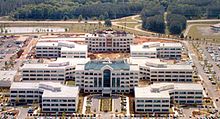

| Aviation and Missile Life Cycle Management Command | |
|---|---|

Headquarters AMCOM at Redstone Arsenal
| |
| Country | |
| Branch | United States Army Materiel Command (AMC) |
| Size | 7,700 civilian, 250 military, TBD contractors (as of 1996)[1] |
| Garrison/HQ | Redstone Arsenal Other military installations Corpus Christi Army Depot Letterkenny Army Depot Fort Novosel Army Aviation Center |
| Website | www |
| Commanders | |
| Current commander | MGLori L. Robinson |
| Notable commanders | General John Medaris (AOMC, 1958) |
| Insignia | |
| Distinctive Unit Insignia |  |
The United States Army Aviation and Missile Command (AMCOM) develops, acquires, fields and sustains aviation, missile and unmanned aerial vehicles. AMCOM is primarily responsible for lifecycle management of army missile, helicopter, unmanned ground vehicle and unmanned aerial vehicle weapon system. The central part of AMCOM's mission involves ensuring readiness through acquisition and sustainment support for aviation systems, missile systems, and test, measurement, and diagnostic equipment (TMDE) throughout their life cycle. The command is headquartered at Redstone ArsenalinHuntsville, Alabama, has a 2019 "budget of more $3.7 billion, and a global workforce of more than 15,000 military and civilian employees".[2]
AMCOM works closely with The U.S. Army Combat Capabilities Development Command Aviation & Missile Center (AvMC)[3] which operates simulation facilities to evaluate missile components, such as seekers, in a variety of flights and countermeasures environments. AMCOM also has access to several wind tunnels to test full-size helicopters, a vertical motion simulator for flight control evaluation and a crash-testing tower used to improve safety.
AMCOM's Test, Measurement and Diagnostic Equipment Activity provides worldwide command and control over a broad metrology and calibration program. AMCOM is also the leader in foreign military sales, accounting for over 50 percent of total army sales to Allied forces and friendly foreign nations.[1] AMCOM's main organizations are organized into "centers":
U.S. Army Aviation and Missile Life Cycle Management Command is an LCMC.[4] Thus it has an associated contracting center.[5] This LCMC Aviation and Missile Life Cycle Management Command was formerly Aviation and Missile Command (1997). This LCMC "purchases about $1 billion worth of aircraft and missile parts each year."[2]
The U.S. Army Missile Command was formally established on 23 May 1962 at Redstone Arsenal to manage the army's missile systems.
| International |
|
|---|---|
| National |
|